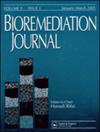本地细菌分离物降解油漆和纺织工业废水的研究
IF 1.9
4区 环境科学与生态学
Q3 ENVIRONMENTAL SCIENCES
引用次数: 0
摘要
本文章由计算机程序翻译,如有差异,请以英文原文为准。
Degradation of paint and textile industrial effluents by indigenous bacterial isolates
Abstract Untreated paint and textile effluents discharged from industries cause serious environmental threats to fauna and flora. This study thus, investigated the potential of different indigenous bacterial cells for the degradation of paint and textile effluents. Paint and textile effluents samples were aseptically collected from paint and textile industries. Physical, chemical, heavy metals properties and microbial load of the effluent were investigated using standard methods. Enrichment, Isolation and identification of bacterial isolates were determined using the standard microbiological methods. Screening of paint and textile effluents degraders was carried out using solid phase screening method. Degradation of paint and textile effluents were determined by Fourier-transform infrared (FTIR) analysis and spectrophotometrically. Results revealed that among the heavy metals analyzed, lead from paint effluent had highest value of 5.49 ± 1.2 mg/L. All the samples collected were turbid with highest and lowest values of 865 ± 1.3 and 514 ± 2.5 (NTU) from paint effluent samples. Paint effluent also recorded highest bacterial count of 6.85 ± 1.13 CFU/ml while paint sludge had the lowest count of 1.16 ± 0. 15 CFU/g. Forty-seven bacterial isolates were obtained from the paint and textile effluents samples. Screening of the 47 isolates showed that 21 isolates possessed the ability to grow on agar plates amended with paints and textile dyes. Out of the 21 positive isolates, 12 isolates were obtained from paint samples while nine isolates were recovered from the textile samples. Highest degradation activity was recorded by Bacillus subtilis (94.37% ±5.35) obtained from textile effluent sample while Micrococcus sp (46.55% ±8.30) from paint polluted soil sample had the lowest degradation activity. FTIR analysis showed the transformation and disappearance of peaks in the treated paint and textile effluents by Bacillus subtilis. This study revealed the ability and effectiveness of Bacillus subtilis in the removal of toxic materials in paint and textile effluents, thus could be applied for industrial use.
求助全文
通过发布文献求助,成功后即可免费获取论文全文。
去求助
来源期刊

Bioremediation Journal
ENVIRONMENTAL SCIENCES-
CiteScore
5.30
自引率
0.00%
发文量
36
审稿时长
9 months
期刊介绍:
Bioremediation Journal is a peer-reviewed quarterly that publishes current, original laboratory and field research in bioremediation, the use of biological and supporting physical treatments to treat contaminated soil and groundwater. The journal rapidly disseminates new information on emerging and maturing bioremediation technologies and integrates scientific research and engineering practices. The authors, editors, and readers are scientists, field engineers, site remediation managers, and regulatory experts from the academic, industrial, and government sectors worldwide.
High-quality, original articles make up the primary content. Other contributions are technical notes, short communications, and occasional invited review articles.
 求助内容:
求助内容: 应助结果提醒方式:
应助结果提醒方式:


